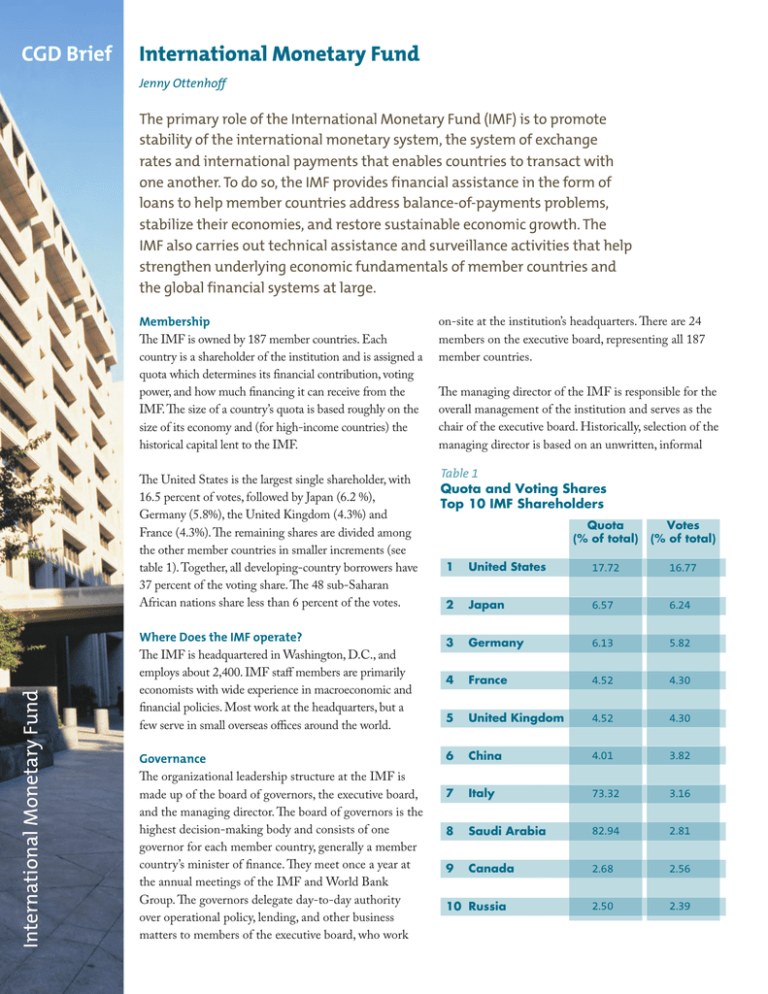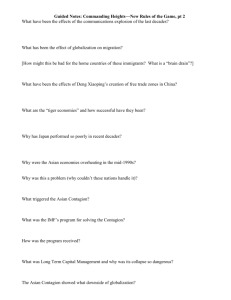
CGD Brief
International Monetary Fund
Jenny Ottenhoff
The primary role of the International Monetary Fund (IMF) is to promote
stability of the international monetary system, the system of exchange
rates and international payments that enables countries to transact with
one another. To do so, the IMF provides financial assistance in the form of
loans to help member countries address balance-of-payments problems,
stabilize their economies, and restore sustainable economic growth. The
IMF also carries out technical assistance and surveillance activities that help
strengthen underlying economic fundamentals of member countries and
the global financial systems at large.
Membership
The IMF is owned by 187 member countries. Each
country is a shareholder of the institution and is assigned a
quota which determines its financial contribution, voting
power, and how much financing it can receive from the
IMF. The size of a country’s quota is based roughly on the
size of its economy and (for high-income countries) the
historical capital lent to the IMF.
International Monetary Fund
The United States is the largest single shareholder, with
16.5 percent of votes, followed by Japan (6.2 %),
Germany (5.8%), the United Kingdom (4.3%) and
France (4.3%). The remaining shares are divided among
the other member countries in smaller increments (see
table 1). Together, all developing-country borrowers have
37 percent of the voting share. The 48 sub-Saharan
African nations share less than 6 percent of the votes.
Where Does the IMF operate?
The IMF is headquartered in Washington, D.C., and
employs about 2,400. IMF staff members are primarily
economists with wide experience in macroeconomic and
financial policies. Most work at the headquarters, but a
few serve in small overseas offices around the world.
Governance
The organizational leadership structure at the IMF is
made up of the board of governors, the executive board,
and the managing director. The board of governors is the
highest decision-making body and consists of one
governor for each member country, generally a member
country’s minister of finance. They meet once a year at
the annual meetings of the IMF and World Bank
Group. The governors delegate day-to-day authority
over operational policy, lending, and other business
matters to members of the executive board, who work
on-site at the institution’s headquarters. There are 24
members on the executive board, representing all 187
member countries.
The managing director of the IMF is responsible for the
overall management of the institution and serves as the
chair of the executive board. Historically, selection of the
managing director is based on an unwritten, informal
Table 1
Quota and Voting Shares
Top 10 IMF Shareholders
Quota
(% of total)
Votes
(% of total)
1
United States
17.72
16.77
2
Japan
6.57
6.24
3
Germany
6.13
5.82
4
France
4.52
4.30
5
United Kingdom
4.52
4.30
6
China
4.01
3.82
7
Italy
73.32
3.16
8
Saudi Arabia
82.94
2.81
9
Canada
2.68
2.56
2.50
2.39
10 Russia
understanding between the United States
and Europe. Under this arrangement,
which dates to the creation of the two
institutions in 1944, the European
governments nominate the managing
director of the IMF. Formally, the
nominated leader is approved and
appointed by the executive board to serve
up to two five-year terms.
Funding
The IMF gets most of its financial
resources from quota subscriptions paid in
by member countries. Quota subscriptions
determine the maximum financial
contribution a member country is obliged
to provide. The United States is currently
the largest member of the IMF with a
quota of about $68 billion.
Lending
The IMF provides loans through several
different instruments, called facilities,
which are tailored to address the different
needs of borrowing countries. The main
lending facilities are nonconcessional and
carry market-based interest rates for shortto medium-term loans. These facilities are
generally used by middle-income member
countries to boost foreign exchange
Distinguishing the IMF from the World Bank
The IMF and the World Bank are distinct institutions with
very different roles in the global community. While they
share a few similarities—they are both headquartered in
Washington, D.C., and they both provide financial assistance
to member countries—they differ in size, scope, and
mandate. The IMF focuses on maintaining and promoting
global financial stability while the World Bank focuses on
poverty reduction and development. The IMF offers short-
reserves. Other facilities provide lines of
credit to countries with a track record of
strong economic policies and performance
to prevent or mitigate the effects of an
external shock and reassure financial
markets and investors (table 2).
The IMF also maintains concessional
lending facilities that provide low- and nointerest loans to low-income member
countries. These facilities help protect
developing countries against the severe
impact of the global financial crisis and
events beyond their control, such as trade
shocks and natural disasters.
term loans to financially distressed countries for general
budget support while the World Bank offers long-term
loans to poorer countries for development. In addition, the
World Bank also offers financial assistance in the form of
nonconcessional loans and grants to poorer countries while
the IMF does not. See the table below for more comparisons
between the two international financial institutions.
IMF
World Bank
Membership
187 member countries
187 member countries
Headquarter
Washington, D.C.
Washington, DC
Staff
2,400
10,000
Funding
Subscribed quotas $376 billion (as of 5/25/11)
Subscribed capital of $189 billion
Recipients
of Funding
All member countries
Middle- and low-income
countries
Biggest Borrowers
(FY2010)
Greece, Portugal, Ireland
India, Mexico, South Africa (IBRD)
India, Vietnam, Tanzania (IDA)
Focus
Macroeconomics and global financial stability
Long-term poverty reduction
and sustainable development
Purpose
*Oversea the international monetary systems
*Maintain stability of exchange rates
*Provide short-term loans for general budget support
*Provide long-term loans, technical support, and
expertise for development assistance in middle-and
low-income countries
Table 2
IMF Lending Facilities
Type
Terms
Duration
Use
Stand-by agreements
Nonconcessional
1–2 years
Most common nonconcessional lending to countries with
short-term balance of payment problems.
Flexible Credit Line
Nonconcessional
1–2 years
For countries with strong financial track records. Used primarily
for crisis prevention or mitigation.
Precautionary Credit Line
Nonconcessional
1–2 years
Only used for crisis prevention by countries with sound
financial fundamentals and policies.
Extended Fund Facility
Nonconcessional
3 + years
Used for longer-term balance of payment problems and
fundamental economic reform.
Extended Credit Facility
Concessional
3 years
Medium-term support to LIC's.
Standby Credit Facility
Concessional
1–2 years
Short-term support to LIC's. Can be used on a precautionary basis.
Rapid Credit Facility
Concessional
1 disbursement
Rapid financial assistance to LIC's.
Both nonconcessional and concessional
IMF loans are often linked to conditions
that aim to adjust borrowing country’s
economic policies and correct underlying
economic or structural problems.
The amount of lending the IMF provides
depends on demand and varies widely
from year to year. Before the 2008 global
financial crisis, total IMF lending was
about $14 billion, its lowest level since
1975. By 2011, lending had reached
around $280 billion, the largest amount
ever committed by the IMF (see figure 1).
Surveillance and Technical Assistance
The IMF does more than lending; it also
carries out financial surveillance and
provides technical assistance to help
countries keep their financial houses in
order. IMF surveillance continually
monitors national, regional, and global
financial developments and provides
policy advice to member countries to
help maintain stability and prevent crises
in the international monetary system.
IMF Loans Committed,
FY2008–2011 (billions USD)
300
250
200
150
100
50
0
2008
2009
2010
2011
It focuses on macroeconomic
developments and provides regular
assessments of global financial markets
and regional economic outlooks.
The IMF also offers technical assistance
and training to help member countries
strengthen their capacity to design and
implement effective financial policies.
Technical assistance is offered in several
areas, including tax policy and
administration, expenditure management,
Issues for Congress
Oversight: Congress exercises
oversight of U.S. participation in
the IMF through legislative
mandates, which can influence
certain institutional policies and
withhold funding unless certain
institutional reforms are met.
Economic Recovery: IMF
surveillance tracks economic and
financial developments worldwide
so that it can help policymakers
with the latest forecasts and
analysis of developments in the
financial markets.
Effectiveness: The effectiveness of
the IMF in spurring economic
recovery and reform in financially
distressed countries is debated,
particularly issues related to
transparency, efficiency, and
control over leveraging of funds. As
the largest single shareholder of
the IMF, the United States exercises
considerable influence over
reforms to improve these areas.
monetary and exchange-rate policies,
banking and financial-system supervision
and regulation, legislative frameworks,
and statistics.
Who Borrows from the IMF?
Any member country may borrow from
the IMF. Governments request IMF
assistance when they find themselves in
an economic crisis, whether caused by or
poor macroeconomic planning or a sudden
shock to their economy. In FY2011, the
largest borrowers were Greece, Portugal,
and Ireland.
Recent Reforms and Future Outlook
The IMF is implementing a number of
reforms to improve governance, enhance its
lending facilities, and preserve available
resources. In 2010, the IMF adjusted voting
shares to increase the representation of
emerging markets and developing countries.
In addition, upon her appointment in 2011,
managing director Christine Lagard
appointed a former deputy governor of the
People’s Bank of China as one of four IMF
deputy managing directors—the first time
that a Chinese official has held such a post.
The IMF has also significantly increased
lending to help member countries cope with
the 2008 financial crisis, including a sharp
rise in concessional lending to low-income
countries. To improve and sustain these
efforts, the IMF created new lending facilities
to better meet countries’ needs and increased
its lending through bilateral loans with
member countries totaling over $250 billion.
The IMF is also working closely with
governments and other international
institutions to improve risk analysis and
prevent future crises. As the impact of the
financial crisis continues to be weighed, the
United States and other nations have a
common interest in ensuring that the IMF is
both well managed and well funded.
Endnotes
Jenny Ottenhoff is a policy outreach associate at the
Center for Global Development. She benefitted from
insights and feedback from Lawrence MacDonald,
Liliana Rojas-Suarez, and Todd Moss during the
drafting of this brief, which draws on previously published work, including the 2010 IMF annual report.
The ABCs of the IFIs: Understanding the U.S.
Role in Shaping Effective International Financial Institutions for
the 21st Century
The International Financial Institutions (IFIs) are major sources of financial
and technical support for developing countries and play a critical role in
promoting economic development and global stability. As the interests of
high-income and developing countries become more linked, the role of the
IFIs will become even more prominent.
1800 Massachusetts Avenue NW
Third Floor
Washington DC 20036
Tel 202.416.4000
2011. Some rights reserved.
BY-NC 3.0
The United States and other nations have a common interest in ensuring
that the IFIs are well managed and well funded. This CGD brief is one of six
on the financial and governance issues facing the IFIs. Please email
publications@cgdev.org to receive any of the others:
• The World Bank
• The International Monetary Fund
• The International Finance
Corporation
• The Regional Development Banks
• Leadership Selection at the IFIs
• The ABCs of the General Capital
Increase







